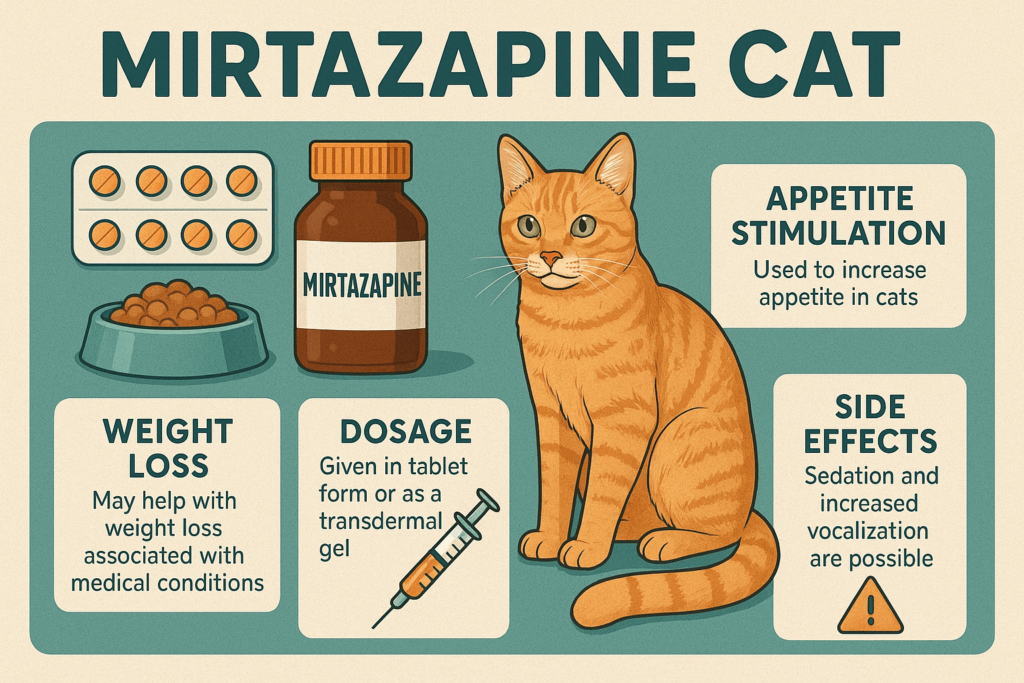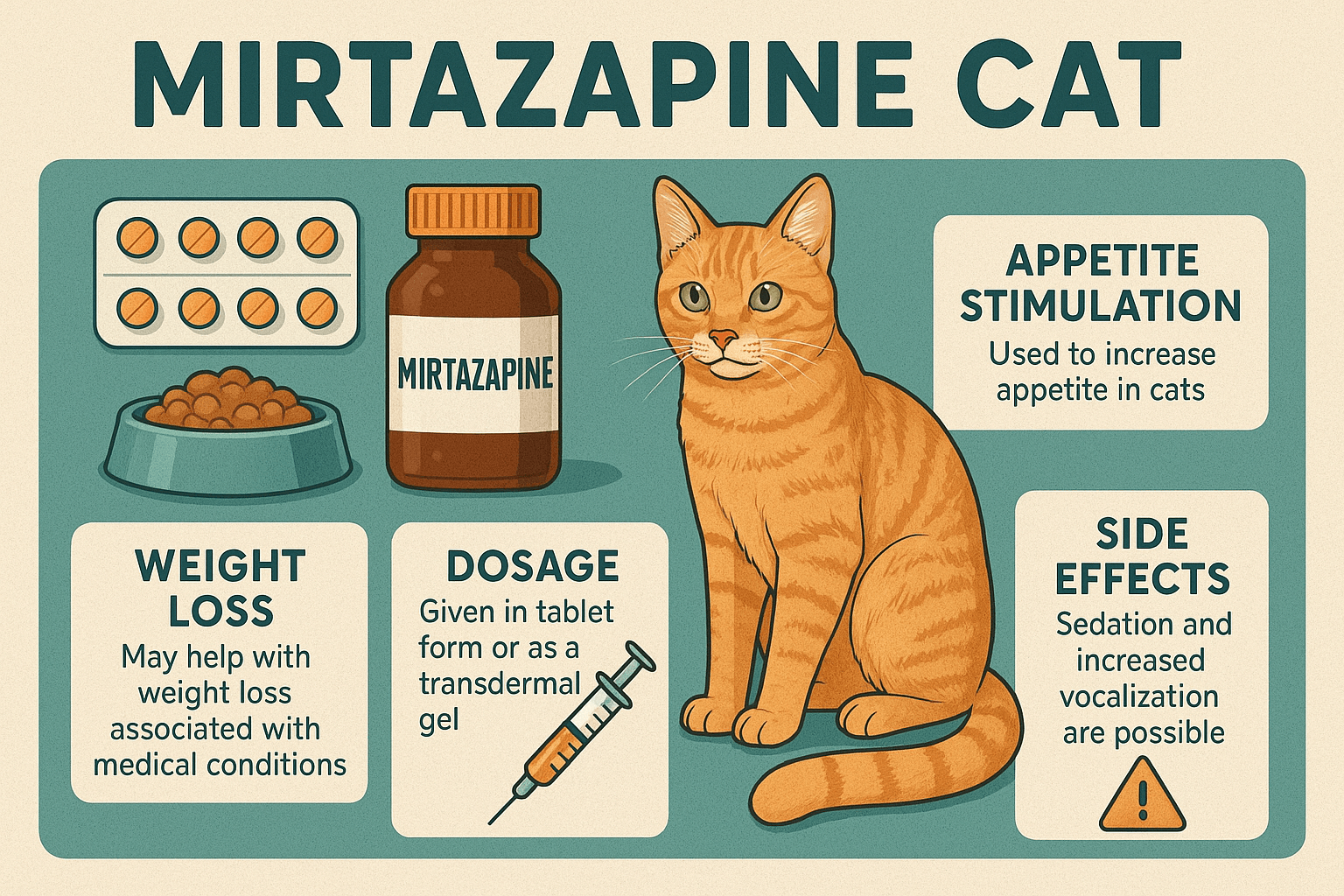Mirtazapine for Cats: What You Need to Know
When it comes to managing certain health conditions in cats, veterinarians often turn to medications like mirtazapine. This versatile drug has gained popularity for its ability to address a range of feline issues, from appetite stimulation to anxiety relief. But what exactly is mirtazapine, and how does it benefit our furry friends? Understanding its uses, benefits, and potential side effects is crucial for cat owners considering this treatment option. Whether your veterinarian has recommended mirtazapine or you’re simply curious about its applications, this guide will provide all the essential information you need to make informed decisions about your cat’s care.
Expert Opinion on Mirtazapine for Cats
“Mirtazapine is a prescription appetite stimulant used in cats to help treat unintentional weight loss caused by medical conditions like cancer, gastrointestinal (digestive tract) disease, and other internal conditions (liver disease, kidney disease).”
Common Uses of Mirtazapine for Cats
Mirtazapine is prescribed for various conditions in cats, making it a valuable tool in veterinary medicine. Its primary applications revolve around improving quality of life for felines facing specific challenges.
Appetite Stimulation:
Mirtazapine is widely used to encourage eating in cats experiencing appetite loss due to illnesses like chronic kidney disease or cancer.Nausea Relief:
The medication helps reduce nausea, which can further aid in restoring a cat’s interest in food and hydration.Weight Management Support:
For underweight or malnourished cats, mirtazapine can promote healthy weight gain by boosting their desire to eat.Anxiety and Stress Reduction:
Mirtazapine’s calming effects make it useful for managing stress-related behaviors, such as those caused by vet visits or environmental changes.Pain Management Adjunct:
While not a painkiller itself, mirtazapine may complement pain management plans by improving overall comfort and well-being.
These diverse applications highlight why mirtazapine is a trusted choice for addressing multiple health concerns in cats.

Benefits of Using Mirtazapine for Cats
Administering mirtazapine can bring numerous advantages to cats struggling with specific health issues. Here are some key benefits that make this medication appealing to veterinarians and pet owners alike.
Rapid Onset of Action:
Mirtazapine typically begins working within hours, providing quick relief for symptoms like appetite loss or nausea.Easy Administration Options:
Available in oral tablets, transdermal gels, and compounded forms, mirtazapine offers flexibility for different administration preferences.Improved Quality of Life:
By addressing underlying issues like poor appetite or anxiety, mirtazapine helps restore a cat’s overall happiness and vitality.Minimal Monitoring Required:
Unlike some medications, mirtazapine generally requires less frequent bloodwork or monitoring, simplifying ongoing care.Versatility Across Conditions:
Its ability to treat multiple symptoms simultaneously makes mirtazapine a cost-effective and efficient solution.
With these benefits, mirtazapine stands out as a practical and effective option for enhancing feline health and comfort.
Check this guide 👉Olive Oil for Cats Constipation: Best 7 Expert Tips!
Check this guide 👉Fiber for Cats: Best 7 Expert Tips!
Check this guide 👉Can You Give a Cat Ibuprofen? Best 7 Expert Tips!
Benefits of Mirtazapine for Cats | Potential Side Effects to Watch For |
|---|---|
Stimulates appetite | Increased vocalization (meowing) |
Reduces nausea | Restlessness or hyperactivity |
Eases anxiety | Sedation or lethargy |
Improves weight gain | Vomiting or diarrhea |
Easy to administer | Rare allergic reactions |
How to Administer Mirtazapine Safely
Proper administration of mirtazapine ensures your cat receives the full benefits of the medication while minimizing risks. Follow these guidelines to ensure safe and effective use.
Consult Your Veterinarian First:
Always obtain a prescription and dosage instructions tailored to your cat’s specific needs.Choose the Right Form:
Decide whether oral tablets, transdermal gel, or compounded liquids work best for your cat’s temperament and condition.Stick to the Prescribed Dosage:
Avoid adjusting the dose without veterinary approval, as incorrect amounts can lead to adverse effects.Monitor for Side Effects:
Observe your cat closely after administration for any signs of discomfort or unusual behavior.Keep Track of Timing:
Mirtazapine is usually given every 24 to 72 hours, depending on the formulation. Set reminders to maintain consistency.
By following these steps, you can ensure your cat receives the maximum benefit from mirtazapine while staying safe and comfortable.
Signs That Mirtazapine Is Working
After starting mirtazapine, it’s important to recognize the signs that indicate the medication is having the desired effect. These positive changes can reassure you that your cat is responding well to treatment.
Increased Appetite:
Noticeable improvement in food intake is one of the first indicators that mirtazapine is working effectively.Reduced Nausea Symptoms:
If your cat stops retching or shows less interest in hiding, it may signal relief from nausea.Improved Energy Levels:
A more active and engaged demeanor suggests your cat feels better overall.Weight Gain Over Time:
Gradual weight gain indicates the medication is helping your cat regain strength and vitality.Calmer Behavior:
Decreased signs of stress or anxiety reflect mirtazapine’s calming properties taking effect.
These signs confirm that mirtazapine is making a positive impact on your cat’s health and well-being.
Potential Risks of Mirtazapine
While mirtazapine is generally safe, it’s important to be aware of potential risks and side effects. Recognizing these early can prevent complications and ensure your cat stays healthy.
Overdose Risk:
Administering too much mirtazapine can lead to severe sedation or agitation. Always follow your vet’s dosage instructions carefully.Allergic Reactions:
Though rare, some cats may develop skin rashes, swelling, or difficulty breathing after taking mirtazapine.Liver or Kidney Concerns:
Cats with pre-existing liver or kidney issues may process the drug differently, requiring adjusted dosages.Behavioral Changes:
Some cats may exhibit unusual behaviors, such as excessive meowing or aggression, which could indicate discomfort.Drug Interactions:
Combining mirtazapine with certain medications can amplify side effects or reduce efficacy.
Understanding these risks ensures you remain vigilant and proactive in safeguarding your cat’s well-being.
Alternatives to Mirtazapine
If mirtazapine isn’t suitable for your cat, there are alternative treatments available to address similar health concerns. Exploring these options can provide additional solutions tailored to your cat’s needs.
Cyproheptadine:
Often used as an appetite stimulant, cyproheptadine is another option for cats struggling to eat.Anti-Nausea Medications:
Drugs like maropitant (Cerenia) specifically target nausea and vomiting in cats.Natural Remedies:
Herbal supplements or dietary adjustments may help stimulate appetite in mild cases.Environmental Enrichment:
Reducing stress through play, toys, or calming pheromones can improve appetite and mood naturally.Nutritional Support:
High-calorie gels or liquid diets can supplement nutrition for cats unable to eat solid food.
These alternatives offer flexibility for cat owners seeking complementary or substitute treatments.
Tips for Managing Side Effects
If your cat experiences side effects from mirtazapine, don’t panic—there are ways to manage and mitigate these issues effectively.
Adjust the Dosage:
Consult your vet about lowering the dose if side effects like hyperactivity or sedation occur.Switch Administration Methods:
Changing from oral tablets to transdermal gel may improve tolerability for sensitive cats.Provide Calming Environments:
Create a quiet, stress-free space to help soothe anxious or restless cats.Monitor Hydration Levels:
Ensure your cat stays hydrated, especially if side effects include vomiting or diarrhea.Reevaluate Underlying Conditions:
Sometimes, side effects arise from underlying health issues that need separate attention.
By addressing side effects proactively, you can ensure your cat continues to benefit from mirtazapine safely.
Frequently Asked Questions About Mirtazapine for Cats
Can mirtazapine be used long-term?
Yes, but only under veterinary supervision to monitor for potential side effects or tolerance buildup.
What should I do if my cat vomits after taking mirtazapine?
Contact your vet immediately, as vomiting could indicate an adverse reaction or improper dosage.
Is mirtazapine safe for senior cats?
It can be safe, but older cats may require adjusted dosages due to age-related health conditions.
How quickly does mirtazapine start working?
Most cats show improvements within a few hours, with peak effects occurring within 6 to 12 hours.
Can mirtazapine interact with other medications?
Yes, it’s important to inform your vet of all medications your cat is taking to avoid harmful interactions.
Empowering Your Cat’s Health Journey with Mirtazapine
Mirtazapine offers a powerful solution for improving the quality of life for cats facing appetite loss, nausea, anxiety, or other related issues. By understanding its uses, benefits, and proper administration, you can confidently support your cat’s health journey. Remember, collaboration with your veterinarian is key to ensuring safe and effective treatment. With the right care and attention, mirtazapine can become a valuable ally in helping your feline friend thrive.
Can a Cat Die from a Cold? Best 7 Expert Tips! Learn how to identify, treat, and prevent feline colds while understanding when to seek veterinary care for your cat’s health.
Cat Screaming for Food: Best 7 Expert Tips! Discover effective strategies to manage your cat's food-related vocalizations and create a peaceful feeding routine.
Aspiration Pneumonia in Cats: Best 7 Expert Tips! Discover causes, symptoms, and treatment advice to protect your cat’s respiratory health and ensure a speedy recovery.
Hip Dysplasia in Cats: Best 7 Expert Tips! Discover expert advice on managing hip dysplasia in cats, from symptoms and prevention to treatment options for a happier, healthier feline life.





